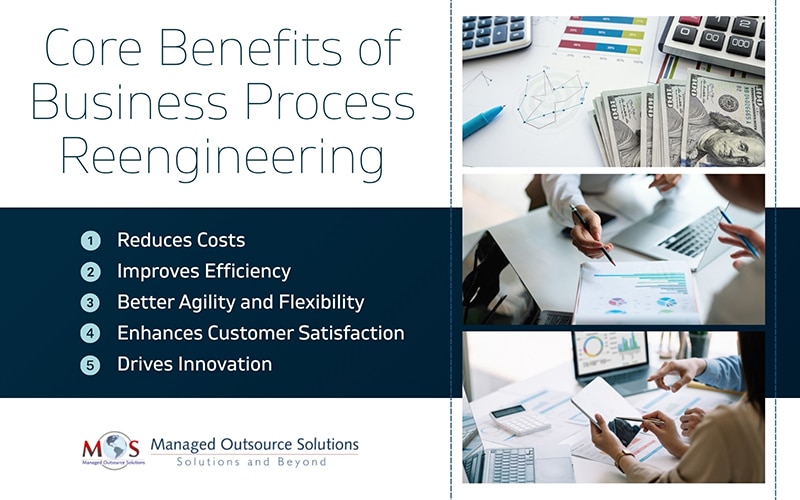Businesses often reach a point where small fixes and surface-level improvements are no longer enough to continue operations and sustain themselves. Processes end up becoming slow, inefficient, and disconnected, making it difficult to meet customer expectations or market changes. In such cases, a radical and complete overhaul of the workflows might be the only viable solution. This strategy is known as business process reengineering (BPR), a structured approach to identify what isn’t working, discard inefficient methods, and redesign core operations from the ground up. However, well-planned strategies for successful BPR implementation are core to putting this idea into practice. Partnering with experienced BPO services is a smart choice for businesses to achieve this objective without straining internal resources and increasing downtimes.
What is Business Process Reengineering?
Business process reengineering (BPR) is a management strategy that involves drastic redesign and rework of the core business functions. By overhauling the existing structure of the internal operations from the ground up, BPR helps organizations to eliminate redundant steps and outdated systems. Unlike incremental initiatives such as business process improvement, BPR focuses on dramatic transformation of key areas such as costs, output, quality, customer service, and speed.
It can be categorized into four phases:
- Identification phase
- Analysis phase
- Design phase
- Implementation phase
The ultimate goal of BPR is to identify, remove, and replace the root causes of issues in an organization by designing new workflows, automating repetitive tasks, and realigning business goals. This results in a shorter operational cycle, reduced overhead expenses, improved productivity levels, and enhanced customer satisfaction. However, BPR is a high-risk, high-reward large-scale process that requires significant resources and strong leadership to realize radical changes. Companies must carefully weigh these risks against the potential reengineering benefits before proceeding. The success of BPR hinges on clear communication, commitment from all levels of the organization, and a willingness to embrace change.
Business Process Reengineering vs. Business Process Management
While business process reengineering (BPR) and business process management (BPM) both aim to improve how a company operates, they approach this goal from different angles and serve distinct purposes.
BPR is focused on radical change. It involves completely rethinking and redesigning core business processes from the ground up to achieve dramatic improvements in performance. This is why BPR projects tend to be large in scale, are often disruptive, and require significant investment in terms of time and resources. The goal is complete transformation and high rewards, driven by introduction of new technologies, models, and workflows.
On the other hand, BPM takes a continuous, steady approach to operational efficiency. It is about managing and optimizing processes on an ongoing basis to ensure they remain efficient and aligned with organizational goals. BPM relies on regular monitoring, measurement, and incremental adjustments rather than sudden, sweeping change. It often involves the use of software tools to model, automate, and control day-to-day processes.
In practice, many organizations benefit from combining both approaches. BPR can reset and reinvent processes that have become inefficient or outdated, while BPM ensures these processes continue to evolve gradually in response to changing demands. Choosing between the two depends largely on the company’s current state, goals, and willingness to take risks.
Key Benefits of Business Process Reengineering for Companies
When implemented correctly, BPR provides numerous advantages and tangible results across various aspects:
- Reduced Costs
For businesses that struggle with high operational costs, longer processing cycles, and yet inefficient results, implementing BPR is a strategic solution. By removing outdated systems, automating processes, and eliminating wastes, BPR designs a new framework for optimized resource allocation. This not only leads to substantial cost savings for businesses but also the removal of non-value activities that do not bring in revenue.
- Improved Efficiency
Rather than focusing on incremental improvements that do not yield long-term results, BPR aims to radically enhance efficiency of internal operations. By detecting underlying causes of bottlenecks and implementing radical changes to processes, companies can reduce the length and complexity of business processes. Optimizing workflows improves employee productivity while saving resources. This results in faster and more responsive processes that deliver highest-quality output.
- Better Agility and Flexibility
The modern business landscape is dynamic and in order to stay competitive, companies must be agile, flexible, and scalable. Implementing BPR in business enables companies to reduce product development times, forecast market demands, and increase sales. This allows them to capitalize on emerging opportunities and meet customer expectations. Moreover, organizations that embrace agility through BPR can adjust their processes to accommodate future growth or market demands without significant internal disruptions.
- Enhanced Customer Satisfaction
Another significant outcome that BPR brings for businesses is enhanced customer experience and higher satisfaction rates. By accelerating information flows and reducing friction with BPR strategy, businesses can execute workflows that are customer-centric and support market requirements. When core processes are aligned with customer needs, pain points, and expectations, companies can deliver superior customer service. For example, improving inventory management leads to timely product availability and faster order fulfillment, resulting in better customer experiences and satisfaction.
- Drive Innovation
Over time, companies may get stuck with outdated workflows, declined service quality, or irrelevant organizational goals that hinder growth. However, with the BPR approach, firms can foster innovation and a culture of continuous improvement. This can include development of new products, service lines, or integration of new technologies. In this AI-driven era, BPR plays a critical role in driving innovation by revealing valuable data and actionable insights. This renewed focus on innovation can open doors to new markets and improve long-term sustainability, strengthening their competitive position.
Key Steps Involved in BPR Implementation
Organizations can successfully implement an effective BPR strategy with detailed and structured initiatives. The key steps include:
- Analyze and Identify
Before executing a BPR strategy, companies must analyze their current workflows, frameworks, and technologies. This initial step is important to find out the areas of improvement, identify misaligned objectives, and assess whether BPR is the ideal solution. A company may require a business process reengineering strategy if any of the following factors are affecting its performance:
- Outdated and rigid processes that no longer meet current business demands
- Poor performance metrics that fail to provide meaningful insights
- Ineffective team communication and collaboration, leading to confusion and delays
- High turnover rates and declining customer satisfaction, signaling deeper organizational issues
- Falling behind competitors in terms of speed, quality, or innovation
A comprehensive, well-researched business needs analysis forms the foundation of a successful BPR implementation. This step ensures that the root causes of inefficiencies are clearly identified, helping to prioritize areas that will deliver the most impactful results when reengineered.
- Create a Team and Set Goals
Form a dedicated cross-functional team to lead the BPR initiative by assigning clear roles and responsibilities. It should include representatives from various departments, such as operations, finance, IT, and customer service, to ensure a full understanding of the existing processes and potential improvement areas. Involve key stakeholders, including managers, employees, and customers, to consider their concerns, feedback, and recommendations. This team should work closely together to gather data and map existing workflows. This step will help to uncover repetitive, redundant, and non-value-adding tasks and anomalies. By identifying pain points through detailed analysis, companies can develop a tailored reengineering strategy.
- Design New Process Models
Guided by this insight, companies should design new processes and workflows from the ground up using the latest software and workflow automation tools. Illustrate the future processes with visual representations such as simplified diagrams and chart flows. These tools can simplify complex processes, making it easier to communicate changes in daily operations to stakeholders.
When designing the new models, it’s crucial to prioritize flexibility and scalability. The business landscape can change quickly, and your new processes should be able to adapt to evolving market conditions, new opportunities, and unexpected challenges. Moreover, involving IT professionals early on ensures that the necessary systems, platforms, and integrations are in place to support the redesigned processes.
- Leverage Change Management
Rolling out a BPR plan without addressing the human side of the change can lead to resistance and confusion. To ensure a smoother transition, implement a comprehensive change management system. This system should include clear communication, training programs, governance framework, and feedback mechanisms for employees at all levels. Change is often met with resistance, so it’s vital to emphasize the benefits of the new processes, both for the organization and for individual employees.
- Monitor, Evaluate, and Adjust
Once the new processes are live, continuous monitoring is essential. Organizations should establish key performance indicators (KPIs) aligned with the reengineering goals, tracking everything from operational efficiency to customer satisfaction. Use real-time data and dashboards to assess how the new processes are performing against predefined goals. Regular evaluations will ensure that the reengineered workflows remain aligned with business objectives, customer needs, and industry trends. Companies must be prepared to make adjustments in case any issue or gaps arise, allocating resources effectively to ensure smooth transition.
Business process outsourcing services can be a reliable option for organizations seeking substantial change without draining in-house resources. When done correctly, it can bring lasting improvements in cost efficiency, operational effectiveness, agility, customer satisfaction, and innovation. These external agencies provide access to world-class experts, cutting-edge tools, and careful planning to transform every level of your organization. By following a structured approach, businesses can use BPR to reset their operations and position themselves in the market with a competitive edge.
Transform outdated workflows into streamlined operations with the expert help of our BPO specialists!





